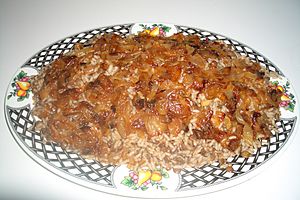Mujaddara facts for kids

A style of Mujaddara
|
|
| Course | Main |
|---|---|
| Place of origin | Levant |
| Main ingredients | Rice or bulgur, lentils, onions |
Mujaddara is a yummy dish from the Middle East. It's made mostly from lentils and rice. People often add tasty fried onions on top. You might also see it spelled as majadra or mejadra. It's a popular and simple meal enjoyed by many.
Contents
What is Mujaddara?
Mujaddara is a traditional dish from the Levant region. This area includes countries like Jordan, Lebanon, Palestine, and Syria. The main ingredients are usually lentils and a grain like rice or bulgur. It's often topped with crispy, fried onions.
The Meaning of the Name
The word Mujaddara comes from Arabic. It means "pockmarked." This name was given because the small lentils mixed with the rice look a bit like pockmarks.
A Very Old Recipe
The first known recipe for mujaddara was written a long time ago. It was in a cookbook called Kitab al-Tabikh. This book was put together in 1226 in Iraq. Back then, it was sometimes made with meat for special parties. But without meat, it was a common meal for people who didn't have much money.
Some people say it's like the "mess of pottage" from an old story. In that story, Jacob bought his brother Esau's birthright for a bowl of lentil stew. Because it was so important for food, there's a saying: "A hungry man would sell his soul for a dish of mujaddara."
Different Ways to Make Mujaddara
Lentils are popular all over the Middle East. They are used in many different dishes. Mujaddara is a favorite meal across the Arab world.
Common Ingredients and Toppings
Most often, mujaddara is made with brown or green lentils and rice. Cooks might add spices like cumin, coriander, or mint for extra flavor. It's always topped with delicious fried onions. People usually eat it with yogurt or a fresh salad. You can enjoy it hot or cold.
Variations in Different Countries
- In Lebanon, the word mjaddara often means a puréed version. This means the lentils and rice are blended until smooth, like a thick pudding.
- Another Lebanese version is called mudardara. In this dish, the rice and lentils stay whole and separate. Both mujaddara and mudardara are topped with caramelized onions. They are usually served with yogurt or a salad.
- Palestinians often use bulgur instead of rice. They call this dish M'jaddaret-Burghul. It helps tell it apart from the rice version. Families often eat it several times a month. It's cooked with olive oil and onion strips. It's served with local sheep's-milk yogurt and green salad.
- Among Israelis from Sephardic and Middle Eastern Jewish families, especially from Syria and Egypt, it's usually made with rice.
- Arab Christians traditionally eat mujaddara during Lent.
- Some people call it "Esau's favorite" because of the old story. Jewish communities traditionally ate it twice a week: hot on Thursday evening and cold on Sunday.
- The dish is also popular among Druze people in the Levant.
Dishes Similar to Mujaddara
Many cultures have dishes that are similar to mujaddara. They also mix lentils with grains.
- In Egyptian cuisine, a dish called kushari combines lentils, rice, macaroni, and tomato sauce.
- In Indian cuisine, lentils cooked with rice are known as khichdi.
- In Iranian cuisine, a similar dish with rice and lentils is called addas polo.
- In Cypriot cuisine, there's a dish called fakes moutzentra. It's very much like mujaddara, made with lentils and rice. Fakes means lentils in Greek.
See also
 In Spanish: Mujaddara para niños
In Spanish: Mujaddara para niños

